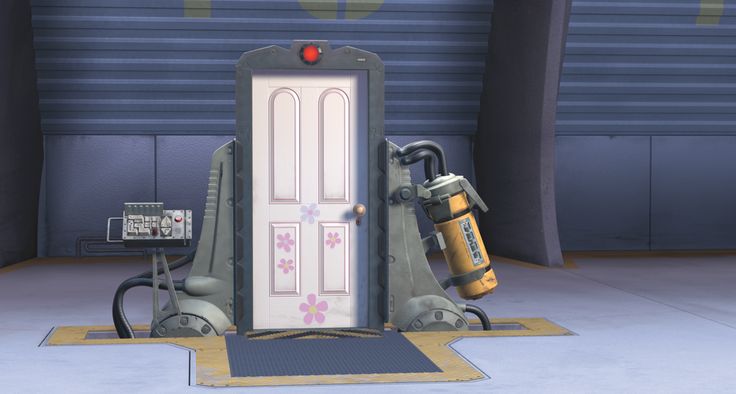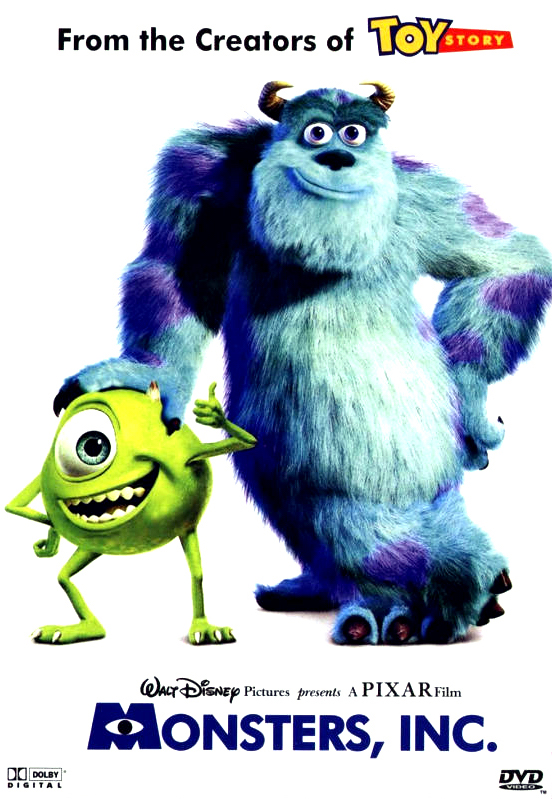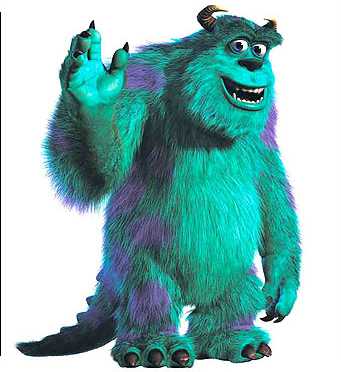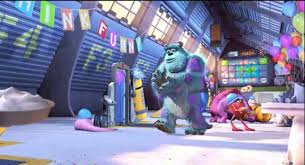Lovable monsters like Sully and Mike of Pixar’s Monsters, Inc (Docter, Silverman and Unkrich, 2001) manage to make the monster world not so scary. Despite their initial employment as professional children ‘scarers’ for the Monsters Inc. corporation that uses scream- energy to power Monstropolis (the film’s monster-inhabited society), the pair prove themselves to be more than the brawn and brain combination at the top of the scare-board. When Boo the human child sneaks through one of the doors used as portals between the human and monster world, they take on the responsibility of caring for her until they can safely return her to the correct door. However, their plan is compromised by sightings of Boo that alert the Child Detection Agency to the situation, and Randall – Sulley’s competition on the scare-floor – whose plotting endangers the entire corporation. The duo must therefore save themselves, Boo and the rest of Monstropolis to return the world to rights.
As with all Pixar films, Monsters, Inc is created through CGI Animation. One way in which the film integrates itself within Pixar tradition is that it provides a deviation from the organised logic of our own world. In this case, the deviation lies in the simultaneous existence of both humans and monsters. However, this deviation is limited to ensure that the film remains uncomplicated for a younger audience and conforms to the family film genre. For example, the viewer is not required to learn a new societal structure, or understand a new form of communication (as might be expected in other genres such as science-fiction), only to understand that this is a world in which monsters exist. Because the monster community functions as a mirror for the types of communities to which the audience likely belongs – namely, urban communities in which the citizens are contributors to a larger cycle of production – the logic of the film is easy to comprehend.
Another way in which Monsters, Inc follows Pixar tradition is that, ‘at least one member of the team is human and at least one member is not human but possesses human levels of intelligence’ [1] which is key to the anthropomorphism of the monsters because it allows them to function as an allegory for humans. This is not just a film about the relationship between humans and other sentient creatures, but about the monsters as a reflection of the society we know. Specifically, Monster’s, Inc offers an allegory for a human society in which capitalism encourages industries that are damaging to the environment and cause harm to the overall existence of society. In this case, Monsters Incorporated is representative of a societal need to move towards more sustainable sources of energy. However, in choosing to employ screams as a source of energy, Pixar not only highlight the ethical dilemmas in energy consumption but also set out a discourse on the use of fear as a source of power. This is a theme that runs throughout the film in both the human –monster relationships as well as relationships between the monsters and the corporation that employs them. Both stylistically and semantically, Pixar films such as Monsters, Inc provide a moral function very much linked to the fact that their major target audience is children. Portrayal of high emotional states, such as those displayed in Randall’s capture of Boo when he tries to implement the scream machine, ensures the audience’s engagement and encourages understanding of the events played out in order to act as a moral guide and somewhat shape the audience’s outlook on the themes addressed in the film.
Non humans in Monsters, Inc are for the most part celebrated as a companion instead of being presented as an enemy species. Munkittrick labels relationships like this as ‘Humans as Partners stories in which exceptional non-humans and exceptional humans share a moment of mutual recognition of personhood.’ [2] However, a reading of the relationship between Boo and Sully cannot conform to this reading because of Boo’s age; as a toddler, Boo is unable to understand the concept of sentience, not to mention apply it to another creature. Instead, Sully and Boo’s relationship can be understood as a reflection of human tendency to be selective in their choice of animal companion. Sully’s character design mimics that of a bear to some extent. His large, furry figure and his deep yet non-threatening voice match with his athletic movements in attempt to create a vague reference to the comforting familiarity of teddy-bears. This design choice is significant because Sully is the character that Boo attaches herself to the most, calling him ‘kitty’ to emphasise how her attraction to Sully is based on physical appearance and familiarity. The fact that Sully is specifically designed to be visually appealing, despite being a monster, to justify Boo’s attachment reflects upon a real-life human tendency to choose companion animals based on physical attraction – cats, dogs, and rabbits for example all share the furry, round-eyed appearance of Sully, and are all common species of house pet.
On one hand, Sully and Boo’s relationship provides a commentary on how humans are drawn towards animals in their childhood. John P. Sisk writes, ‘when we are young we accept them as equals or even, because of their special glamor and mystery, as superiors’. [3] This is true for Boo, who takes a shining to both Sulley and Mike and trusts them with her safekeeping. The first time the audience sees Boo is in a shot of her lifting and dropping Sulley’s tail repeatedly in playfulness. Despite having been scared in the past by Randal, Boo displays no shyness in her contact with Sulley, indicating that she has no learned behaviour that distances her from non-human creatures.. On the other hand, reading the monsters as allegories for humans means an inversion of human/animal behaviour. Therefore, Boo also represents the animal in the film. This is demonstrated in Sulley’s reluctance to touch her in the moments after he discovers she has followed him into the changing rooms, cowering in the corner as if she posed a dangerous threat. Of course, he thinks that this is the case, and this is just one example of how the theme of fear in the film feeds into the power of the corporation. Through perpetuating a dangerous view of humans, Waternoose – C.E.O of Monsters Incorporated – and the corporation as a whole avoids the development of empathy between the species and therefore increases the likelihood of the monsters’ willingness to continue as scarers.
The monster society within Monsters, Inc strongly perpetuates the idea that each citizen is to contribute to the functioning of the community, proven when the characters walk past a street sweeper who just happens to be able to digest rubbish, and the produce handler that happens to have the most tentacles. Images such as these suggest a society run through exploitation of its citizens. This is explored further in the promotional video aired for Monsters Inc, in which the company states ‘we scare because we care’, highlights the energy company’s overly-enthusiastic effort to appear as a friend to the community. This is symbolic of the energy companies in the real life world; Monsters Inc is offering a parody of a society in which citizens can so easily turn a blind eye to the exploitation of the environment for fossil fuels, for example, and the workers who are expected to completely devote themselves to the company at which they work.
As mentioned, a major theme of the film is that of fear being the origin of power. This is evidenced in the monsters’ fear towards touching a child, which is also an inversion of real life human fear of monsters. Waternoose is the character that benefits from this. His manipulation of the workers is demonstrated in his handling of Boo without hesitation when he finds out that the duo have been hiding her, strongly indicating that he knew there was no threat all along. Waternoose represents a capitalist leader at the top of the chain, who is willing to feed from the bottom to serve his own purposes. When Mike and Sully discover that laughing creates more energy than screaming, this is symbolic of real-life energy companies and their need to swap to renewable energy sources, instead of using sources that are damaging the environment. In mirroring the monster world with our own, Pixar have estranged our own world in an attempt to encourage us to reanalyse it, specifically in our use of energy.
Shrek (Adamson and Jenson, 2001) is another animated animal –exploration released in the same year as Monsters, Inc. For lovers of Pixar, Shrek offers another world in which humans and animals co-exist, only with much more interaction between the two. The film also offers an allegory for racial oppression in the treatment of the animal groups, as fairytale creatures find themselves exiled to the outskirts of society, right into the path of our protagonist ogre. Shrek allows deeper exploration of what it means to be an outcast, and what full integration into a community means not just through the characters, but in its handling of physical locations such as the swamp and the castle that set the scene for isolation, but in the end become locations that facilitate the meeting of several characters.
[1] Kyle Munkittrick, ‘The Hidden Message in Pixar’s Films’, Discover Magazine (2011) http://blogs.discovermagazine.com/sciencenotfiction/2011/05/14/the-hidden-message-in-pixars-films/#.VqVQ3VLpyAh [accessed 20th January 2016]
[2] (Munkittrick)
[3] John P. Sisk, ‘The Animated Cartoon’, Prairie Schooner, Volume 27 (1953) http://www.jstor.org [accessed 22nd January 2016] p.243
Further Reading
Elizabeth Scherman, ‘Monsters Among us: Construction of the Deviant Body in Monsters, Inc. and Lilo and Stitch’, Academia, http://www.academia.edu/1570444/_Monsters_among_us_Construction_of_the_deviant_body_in_Monsters_Inc._and_Lilo_and_Stitch._ [accessed 22nd January 2016]
Darko Suvin, ‘Estrangement and Cognition’, Strange Horizons (2014) https://www.strangehorizons.com/2014/20141124/1suvin-a.shtml [accessed 22nd January 2016]
Keith Booker, Disney, Pixar, and the Hidden Messages of Children’s Films, (Conneticut: Greenwood Press, 2009)
Bibliography
Monsters Inc. Dir. Docter, Silverman and Unkrich. Buena Vista Pictures Distribution, 2001.
Munkittrick, Kyle, ‘The Hidden Message in Pixar’s Films’, Discover Magazine (2011) http://blogs.discovermagazine.com/sciencenotfiction/2011/05/14/the-hidden-message-in-pixars-films/#.VqVQ3VLpyAh [accessed 20th January 2016]
Sisk, John P. ‘The Animated Cartoon’, Prairie Schooner, Volume 27 (1953) http://www.jstor.org [accessed 22nd January 2016]



